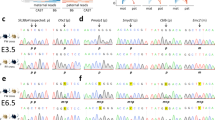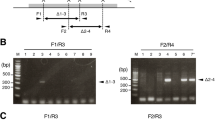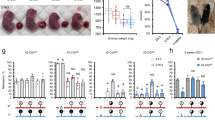Abstract
A new imprinted gene has been discovered in mice using the technique of restriction landmark genomic scanning (RGLS) with methylation sensitive enzymes. Eight out of 3,100 strain–specific Notl and BssHII spots were identified as imprinted in reciprocal F1 hybrids. Subsequently, we isolated a genomic clone for one locus on proximal chromosome 11 near the Glns locus, an imprinted region in uniparental disomic mice, and its corresponding cDNA clone. Expression of this transcript from the paternal allele was established using RT–PCR of reciprocal F1–hybrid mice. The amino–acid sequence deduced from the cDNA showed significant homology to the U2 small nuclear ribonucleoprotein auxiliary factor 35 kDa subunit.
This is a preview of subscription content, access via your institution
Access options
Subscribe to this journal
Receive 12 print issues and online access
$209.00 per year
only $17.42 per issue
Buy this article
- Purchase on Springer Link
- Instant access to full article PDF
Prices may be subject to local taxes which are calculated during checkout
Similar content being viewed by others
References
Solter, D. Differential imprinting and expression of maternal and paternal genomes. Ann. Rev. Genet. 22, 127–146 (1988).
Cattanach, B.M. & Kirk, M. Differential activity of maternally and paternally derived chromosome regions in mice. Nature 315, 496–498 (1985).
Barlow, D.P., Stöger R., Herrmann, B.G., Saito, K. & Schweifer, N. The mouse insulin-like growth factor type 2 receptor is imprinted and closely linked to the Tme locus. Nature 349, 84–87 (1991).
DeChiara, T.M., Robertson, E.J. & Efstratiadis, A. Parental imprinting of the mouse insulin-like growth factor II gene. Cell 64, 849–859 (1991).
Left, S.E. et al. Maternal Imprinting of the mouse Snrpn gene and conserved linkage homology with the human Prader-Willi syndrome region. Nature Genet. 2 259–264 (1992).
Cattanach, B.M. et al. A candidate mouse model for Prader-Willi syndrome which shows an absence of Snrpn expression. Nature Genet. 2, 270–274 (1992).
Özçelik, T. et al. Small nuclear ribonucleoprotein polypeptide N (SNRPN), an expressed gene in the Prader-Willi syndrome critical region. Nature Genet. 2 265–269 (1992).
Bartolomei, M.S., Zemel, S. & Tilghman, S.M. Parental imprinting of the mouse H19 gene. Nature 351, 153–155 (1991).
Reik, W., Collick, A., Norris, M.L., Barton, S.C. & Surani, M.A. Genomic imprinting determines methylation of parental alleles in transgenic mice. Nature 328, 248–251 (1987).
Swain, J.L., Stewart, T.A. & Leder, P. Parental legacy determines methylation and expression of an autosomal transgene: a molecular mechanism for parental imprinting. Cell 50, 719–727 (1988).
Sasaki, H. et al. Inherited type of allelic methylation variations in a mouse chromosome region where an integrated transgene shows methylation imprinting. Development 111, 573–581 (1991).
Stöger, R. et al. Maternal-specific methylation of the imprinted mouse lgf2r locus identifies the expressed locus as carrying the imprinting signal. Cell 73, 61–71 (1993).
Hayashizaki, Y. et al. Restriction landmark genomic scanning method and its various applications. Electrophoresis 14, 251–258 (1993).
Hatada, I., Hayashizaki, Y., Hirotsune, S., Komatusbara, S. & Mukai, T. A genomic scanning method for higher organisms using restriction sites as landmark. Proc. natn. Acad. Sci. U.S.A. 88, 9523–9527 (1991).
Vanyushin, B.F., Tkacheva, S.G. & Belozersky, A.N. Rare bases in animal DNA. Nature 225, 948–949 (1970).
Hirotsume, S. et al. Molecular cloning of polymorphic markers on RLGS gel using the spot target cloning method. Biochem. biophys. Res. Commun. 194, 1406–1412 (1993).
Manly, K.F. & Elliott, R.W. RI manager, a microcomputer program for analysis of data from recombinant inbred strains. Mamm. Genome 1, 123–126 (1991).
Hayashizaki, Y. et al. A new method for constructing Notl linking and boundary libraries using a restriction trapper. Genomics 14, 733–739 (1992).
Lindsay, S. & Bird, A.P. Use of restriction enzyme to detect potential gene sequences in mammalian DNA. Nature 327, 336–338 (1987).
Bird, A., Taggart, M., Frommer, M., Miller, O.J. & Macleod, D. A fraction of the mouse genome that is derived from islands of nonmethylated, CpG-rich DNA. Cell 40, 91–99 (1985).
Zhang, M., Zamore, P.D., Carmo-Fonseca, M., Lamond, A.I. & Green, M.R. Cloning and intracellular localization of the U2 small nuclear ribonucleoprotein auxiliary factor small subunit. Proc. natn. Acad. Sci. U.S.A. 89, 8769–8773 (1992).
Bradbury, M.W., Isola, L.M. & Gordon, J.W. Enzymatic amplification of a Y chromosome repeat of the sex of preimplantation mouse embryos. Proc. natn. Acad. Sci. U.S.A. 87, 4053–4057 (1990).
Blin, N. & Stanfford, D.W. A general method for isolation of high molecular weight DNA from eukaryotes. Nucl. Acids Res. 3, 2303–2308 (1976).
Hirotsune, S. et al. New approach for detection of amplification in cancer DNA using restriction landmark genomic scanning. Cancer Res. 52, 3642–3647 (1992).
Devereux, J., Haeberii, P. & Smithies, O. A comprehensive set of sequence analysis programs for the VAX. Nucl. Acids Res. 12, 387–395 (1984).
Author information
Authors and Affiliations
Rights and permissions
About this article
Cite this article
Hayashizaki, Y., Shibata, H., Hirotsune, S. et al. Identification of an imprinted U2af binding protein related sequence on mouse chromosome 11 using the RLGS method. Nat Genet 6, 33–40 (1994). https://doi.org/10.1038/ng0194-33
Received:
Accepted:
Issue Date:
DOI: https://doi.org/10.1038/ng0194-33
This article is cited by
-
Restriction landmark genomic scanning
Nature Protocols (2006)
-
Novel paternally expressed intergenic transcripts at the mouse Prader–Willi/Angelman Syndrome locus
Mammalian Genome (2005)
-
Structural and functional preservation of specific sequences of DNA and mRNA in apoptotic bodies from ES cells
Apoptosis (2005)



